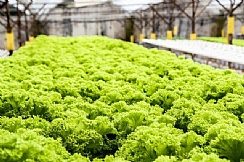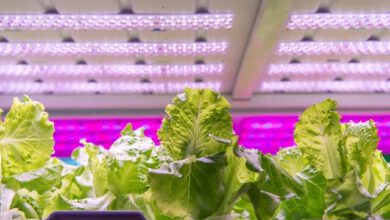The Ammonium/Nitrate Ratio Importance in soilless growing medium
Ammonium metabolism requires much more oxygen than Nitrate exchange in the roots
Adi Nave, Gat Fertilizers Agronomist, adin@gatfertilizers.com


Soilless growing medium cultivation is considered the most advanced system in modern agriculture. This is primarily because when growing in soil, the ability to influence in the plant’s underground section is limited, whereas control can be maximized with soilless growing medium crops (worldwide defined as ‘hydroponics’ method), both over the above-ground section of the crop as well as over the root system.
Cultivation in soilless growing medium requires skills and precisions in crop management control over growing conditions of the crop’s underground section. It is attained through maintenance of the composition of nutrients material in the soilless solution, preserving the root environs with a low level of salinity and maintaining optimal pH for cultivation.
Appropriate pH control may be done by controlling acidification by injection acid to irrigation water. However, it’s important to remember that nitrogen ions composition is significant in this aspect.
Nitrogen is the foundation stone of Amino acids, Proteins and Chlorophyll. Plants absorb Nitrogen both as Nitrate (NO3- ) or Ammonium (NH4+) and therefore Nitrogen consumption is usually comprised of a combination of these two forms. The Ammonium / Nitrate ratio is highly significant and influences of soilless growing mediums crops. For optimal absorption and growth, each type of plant requires a different Ammonium / Nitrate ratio. The proper ratio to be applied varies with temperature, stage of growth, pH in the root zone and the characteristics of the growing medium.
Ammonium metabolism requires much more oxygen than Nitrate exchange in the roots. Ammonium metabolism occurs in the roots, where it reacts with sugars, so that the plant invests energy in order to transfer sugars from their production site in leaves to the roots. On the other hand, Nitrate is transferred from the roots to the leaves, where it interacts with the sugars.
Plant respiration is increased at higher temperatures, meaning that sugar consumption is faster, making it less available for Ammonium metabolism in the roots. Therefore, the practical conclusion is that at higher temperatures it’s recommended to use fertilizer with a lower Ammonium / Nitrate ratio. At lower temperatures Ammonium nutrition is a better choice, since the oxygen and sugars are more available in the root area.
The plant maintains electrolyte balance in the root cells, so that each positively charged ion taken from the ground solution releases a positively charged ion from the root cells into the solution. This process is also correct for negatively charged ions.
Therefore, when the plant’s roots absorbs Ammonium (NH4+) it releases a proton (H+) to the substrate solution, the increase in protons concentration around the roots reduces the pH, By contrast, when the plant absorbs Nitrate (NO3- ), it releases hydroxide (HO-), which increases the pH around the roots (Rhizosphere)
These facts are particularly important when growing on soilless. since the roots are likely to easily influence the solution’s pH’, defending on the nitrogen configuration absorbed. This is occurred because their volume is relatively great in the substrate’s volume. In order to prevent an extreme decline in acidity to a level injurious to the plant, an appropriate Ammonium / Nitrate ratio must be maintained, according to the type of crop, the temperature and the growth stage.
Under certain conditions it’s possible that the pH will not react as expected due to Nitrification (the process of Ammonium decomposition by bacteria – Diagram 1). Nitrification is a very swift process, and the additional Ammonium is likely to decompose quickly and be absorbed as Nitrate, thereby increasing the pH level in the root area instead of reducing it.
Diagram 1: Nitrification Schema
For most plants’ root systems, when absorbing nitrogen, there is a clear preference for Ammonium as opposed to Nitrate. But by contrast, the plant’s ability to self-ferment the area of the root zone is so efficient that a plant growing in a solution containing Ammonium as an exclusive source of nitrogen will reduce the solution’s pH down to less than 3.5, and inflict on itself irreversible damage.
For example, growing tomatoes in a solution whose sole source of nitrogen is Ammonium Nitrate, notwithstanding the equal ratio of Ammonium and Nitrate particles in the solution, for every ion of Nitrate the plant will absorb 4 Ammonium ions. The implication of this process where a plant grows in soilless growing medium with limited root volume and receives primarily Ammonium nutrition, is that there is a great chance the root zone will be acid (Graph 1).
Graph 1: Growing tomatoes in soilless growing medium
Ammonium is a Cation (positively charged ion) and therefore competes with other cations (Potassium, Calcium, Magnesium) in being absorbed by the roots. Unbalanced fertilization, with too much Ammonium, is liable to cause Calcium and Magnesium deficiencies (absorption of Potassium is less affected by this competition). Fertilization with too much Ammonium is likely to cause a Calcium deficiency in the fruit and appearance of Blossom-End Rot, especially in a warm, dry climate.
Under high temperature conditions in the growing medium, activity of the Nitrobacter bacteria, that decompose Nitrite into Nitrate is limited, hence there is concern about accumulation of Nitrite (NO2 ̄) which is poisonous to the plant. Lowering the amount of Ammonium added to the fertilizer can lessen the risk of poisoning.
To conclude, the Ammonium / Nitrate ratio is likely to change the pH near the root zone. This change is likely to influence the solubility and availability of other basic nutrients. Hence, using fertilizer containing Ammonium for growing in soilless growing medium is a step requiring extreme caution, especially with crops that are sensitive to Calcium and Magnesium deficiencies (tomato and pepper). The latter is totally true during the winter when the rate of Nitrification in the substrate decreases precipitously as the temperature drops. Most of the Ammonium nitrogen provided to the plant remains as Ammonium, is absorbed as Ammonium and will cause serious damage to the plant.
Gat Fertilizers offers for soilless growers for fertigation its ” Or” solution, with a low Ammonium concentration, 90% of its nitrogen derives from Nitrates, and only 10% as Ammonium. This fertilizer poses no concern for high-Ammonium damage and is also safe to use in winter. Similarly, the Ammonium / Nitrate ratio can be adjusted in different fertilizer solutions such as “Shafir”, “Sulphur Shafir”, “Golan”. In case of irrigation with desalinated water, it is recommended to fertilize in a separate container with “Yamit” Solution (a solution of Calcium Nitrate and Magnesium Nitrate).
All questions may be sent to Gat’s agronomists,
Adi Nave
Gat Fertilizers Agronomist
adin@gatfertilizers.com
Sources:
1. Yermiyahu, U., I. Shamai R. Peleg N. Duda D. Shtienberg (2006) Reduction of Botrytis cinereal
a. sporulation in sweet basil by altering the concentrations of nitrogen and calcium in the irrigation solution, Plant Pathology 55: 544–552.
2. Effect of water quality, nitrogen nutritional level and nitrate : ammonium ratio on pepper cultivation Cohen S., Oshoroviz A., Hashmonai D., Offenbach R., Zvieli Y., Golan R. – Central and Northern Arava
3. Kafkafi, U., I. Walerstein and S. Friegenbaum. 1971. Effect of potassium nitrate and ammonium nitrate on the growth, cation uptake and water requirement of tomato grown in sand culture. Israel J. Agr. Res. 21:13-20.
4. AMMONIUM/NITRATE RATIO – SMART FERTILIZER MANAGEMENT
5. Yaron Yutal, Gat Fertilizers – Considerations for selecting a greenhouse substrate




